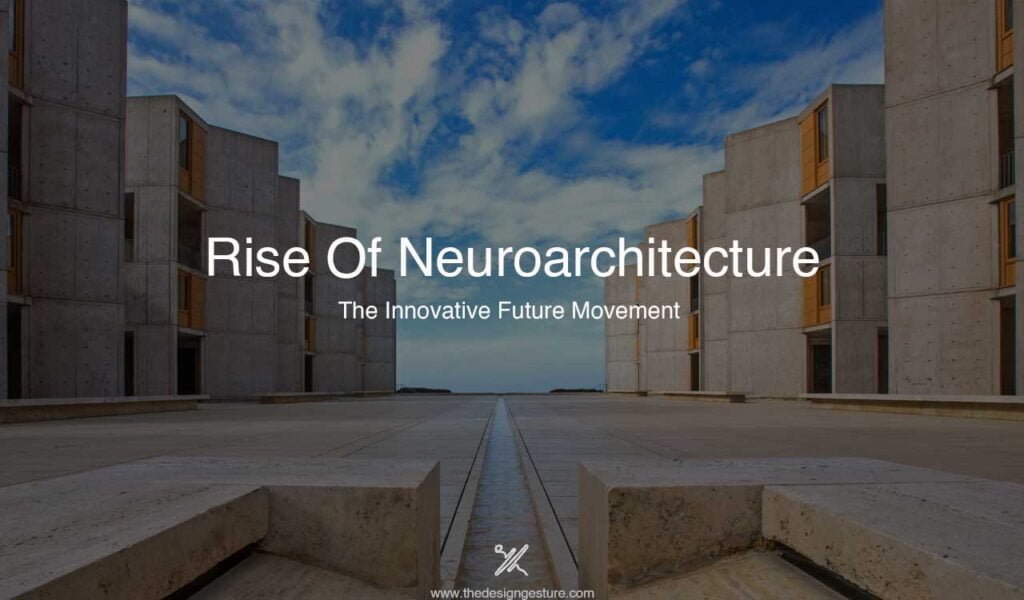Human brains are weird, complex, and driven by a delicate yet robust interplay of various opposing forces. The simple act of walking through a corridor has a perplexing reaction in our brains that is beyond our awareness. As Moverec popularly says, “We are least aware of what our minds do best.” The brain responds differently to every activity in every other physical environment. These responses of the brain are determined by varied factors, such as cognition, culture, form, and configuration of the environment, and even the period of exposure to the environment. Thus, architecture changes our brains and behavior while designing the environments in which we live. Therefore, architecture defines and shapes our lives.
Neuroarchitecture is a study of understanding how architectural surroundings influence our mental processes and behavior to design spaces that improve our wellbeing. Ancient builders and architects had understood what is at the heart of neuroscience. It is evident in the pyramids, which create a sense of awe in us. But, now, what is new is that we can measure how, and understand why, our brains respond in a way. And, it is where neuroarchitecture comes into play.
Table of Contents
The trend of Architectural imagery
“Digital has made architectural photography very slick, sometimes you do not know if it is a photo or if it is a rendering and that I find very disturbing” – Helene Binet
Within architectural society, there has long been a trend of successful design determined by how aesthetically pleasing the design is. Almost all the past movements and ‘isms’ have ultimately been informed by their aesthetic styles and the philosophies that drove them. And, now it has taken the form of Architectural renders, where people had to create their own experiences of the structures, fully relying on the individual memory and visual impression of the images they are presented with.
An architect satisfies the client with an architectural image, leaving the architects to rely on intuition rather than experimental truth. These days, architect’s primary aim seems to be shifting from the well-being of the client to meagerly selling his/her design. For that, they end up showing things in their design that might not actually be that way in reality. For example, they might introduce random greenery in their views without taking into account the species, size, and several plants/trees that the landscape can hold. But because greenery and nature infuse a positive impact on the user, architects tend to show a lot of it in their design images.
What does neuroscience teach us about architecture?
Most of the time, architects are viewed as an added expense to the making of a building. Construction wins over design. Despite the valuable knowledge and understanding of design that they should actually impart to society, architects always become at the forefront of functionality and aesthetics in spaces.

As architects, we always admire the grandeur and the structural aesthetics of Gothic architecture. We appreciate the flying buttresses, the ribbed vaults, and the stained glass windows as aesthetic wonders and structural marvels. But we do not investigate the reason why such grandeur enchants us. Why is it that it is being a constant inspiration in literature and film, and how do the aesthetics of the gothic architecture affect the people? This is because our process works at the level of recognition rather than analysis, that we recreate the same buttresses and ribs to impose grandeur in a structure, and the knowledge behind the aesthetics of the structure remains hidden. This hidden knowledge can be brought about by neuroarchitecture.
Neuroarchitecture and Neuroscience
Neuroarchitecture is a discipline that seeks to explore the relationship between neuroscience and modern architecture in designing buildings and other artificial structures that make up the artificial environment that humans live in. Neuroarchitecture addresses the human response to the design elements that make up a built environment. Neuroarchitecture is a new movement, which, unlike other movements, is less about architecture and more about humans who experience it. It is based on the premise that artificial elements added by humans significantly impact the function of the brain and nervous system.
Measuring human well-being
Architecture has developed various metrics to measure different parameters of the buildings. The Building Code, for example, provides quantifiable targets for the construction of buildings; it also gives building performance measures such as minimum thermal comfort levels and minimum lighting levels. Etc. LEED has given a metric to measure whole building energy performance. We also measure the holistic performance of the buildings through post-occupancy evaluations. But, neuroarchitecture is the way of measuring the impact of humans on the buildings, which has long been absent in architecture.
Science is getting better at measuring things. So, why can’t we use scanners as someone walks through the streets to know how it affects the brain? Special cells found in the hippocampal region of our brains are tuned in to geometry and how our spaces are organized. Whenever you enter a room or any environment, these cells navigate and store spatial information in the form of cognitive maps. These cognitive maps can be recorded by the instruments to know how we respond to a space.
“Pure” neuroarchitecture is based on instruments of neurobiology, such as electrocardiograms, electroencephalograms, or sweat sensors, to objectively measure how our bodies react to certain architectural stimuli. For example, the eye-tracking sensor is used to find out where people’s attention is focused and which architectural elements had sought their attention. It revealed that people tend to ignore blank facades but respond positively to buildings that mirror the structure of the human face.
Neuromorphic architecture
Neuroarchitecture examines and even measures the impacts of buildings on human brains. But what if the brain functions are fed into the design of buildings and it informs how a building is to be built? It opened up a new form of study known as neuromorphic architecture. Neuromorphic architecture approaches the design of rooms, buildings, and buildings integrated into a landscape by lessons from modeling brain computation. Neuromorphic architecture contributes to Smart Architecture, which changes according to our needs and brain functions. It works in parallel with artificial intelligence.
The current technology has reinvented the automated control of lighting and temperature of the spaces through apps. Through these progressions, our surroundings can be programmed to respond to our actions to assist us with the help of technology, which could be accomplished by neuromorphic architecture. For example, a stair that transforms into a ramp, when it recognizes a wheelchair, can assist elderly and physically challenged people. An interactive kitchen that would help a blind person navigate through it.
Finally, today, with neuroarchitecture, we can understand human brains and their psychological responses to design. Neuro studies prove that facades that are complex and interesting to have a positive impact on people in an urban environment, whereas plain, monotonous facades affect negatively. A large expanse of grass hardly impacts our brains when compared to a variety of greenery. Hence, the knowledge gained from biomorphic research by virtual reality, sensors, and other instruments paves the way for designing future cities and buildings that are perfectly aligned with proper analysis of the aesthetic, emotional, and functional values of the built environment.




